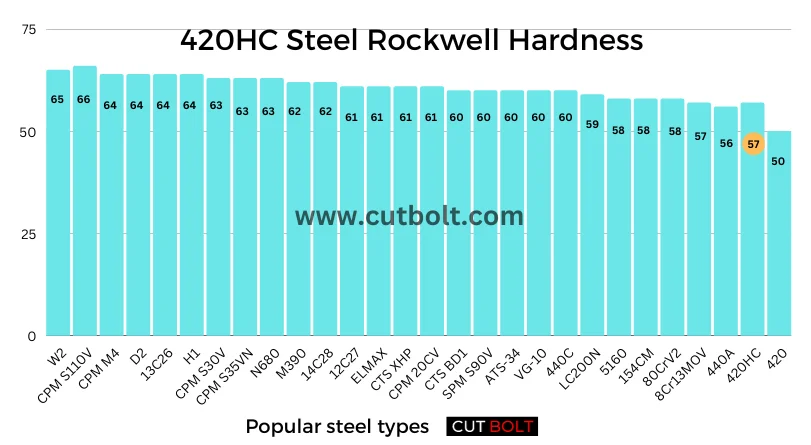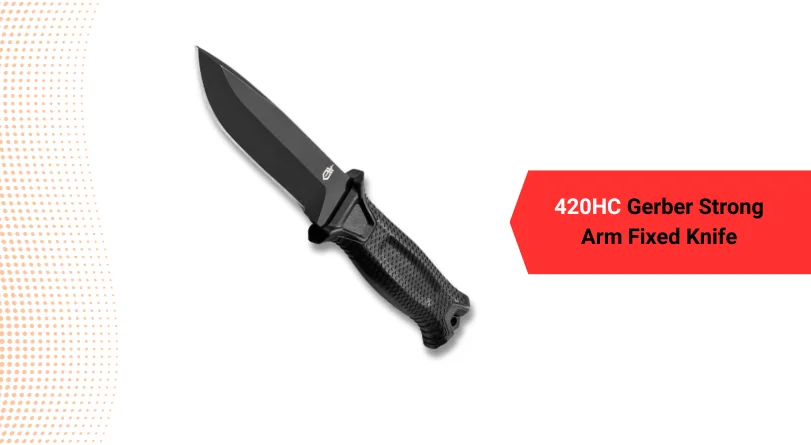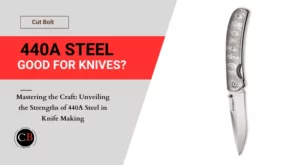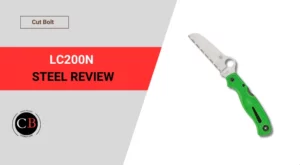You love knives. You slice, you dice, you conquer kitchen mountains. But when it comes to steel, you’re lost in a jungle of jargon. “420HC”? Sounds like a sci-fi villain, not a knife blade! Fear not, brave adventurer! We’re here to slash through the confusing specs and tell you the real deal on this popular (and sometimes controversial) steel.
Is 420HC a Good Knife Steel?
Well, I couldn’t just pass by this steel without researching it a bit. So, if you want to know more about 420HC, I invite you to read on with pleasure. As always, I have tried to answer all questions that are of interest to give a quick overview. These are questions about chemical composition, hardness and suitability as knife steel to name the most important.
Table of Contents
What is 420HC steel?
420HC is a martensitic steel of the 420 series and a further development by the manufacturer LATROBE (now Carpenter/Cartech). The “HC” in its name stands for “high carbon”, meaning that the steel can be well hardened by heat treatment to achieve higher hardness levels. In addition to the carbon elements, the steel contains 13% chromium, which gives it corrosion-resistant properties.
420HC is mainly used for the production of cutlery, scissor blades, surgical tools, scissors, needle valves and for a few other applications. It is a cost-effective and reliable steel used by Buck Knives and other knife manufacturers to produce rugged and versatile knives.
420HC steel is also available under the name Case Tru-Sharp (Latrobe).

420HC steel chemical composition
| Element | Portion | Effect |
| Chrome | 13.0% | Improves wear resistance, heat resistance and scale resistance. It increases tensile strength because it acts as a carbide former. Use of rust-proof or stainless steel, as it increases corrosion resistance from a mass proportion of 12.2%. Reduction in weldability. |
| Carbon | 0.46% | Increasing hardness and tensile strength. In larger quantities, increase in brittleness and reduction in forgeability and weldability. |
| Manganese | 0.4% | Improves hardness and tensile strength. |
| silicon | 0.4% | Improves strength. |
| Vanadium | 0.3% | Increasing hardness, increasing wear resistance and improving tempering resistance. |
420HC is rustproof and stainless steel
420HC is both a rust-free steel and a stainless steel. To be considered rustproof, it must have a chromium content of at least 10.5-13% dissolved in the austenite or ferrite, depending on the definition (see here). To be a stainless steel, its sulfur and phosphorus content (so-called iron companions) must be below 0.025% (see here), which is the case here.
What is the hardness (HRC) of 420HC steel?
The hardness of 420HC steel typically falls around 57 HRC (Rockwell Hardness Scale). The specific hardness can vary based on factors such as the heat treatment process applied by the manufacturer and the intended application of the steel.

Properties of 420HC steel
According to the chemical composition and hardness of 420HC, it offers the following properties and characteristics:
Edge retention
The ability of a blade to retain its sharpness is determined by several factors. A softer steel tends to lose its sharpness more quickly than a harder steel. However, a harder steel with high brittleness would also affect sharpness retention. This requires a clever combination of the elements that contribute to hardness and brittleness.
420HC is a comparatively soft steel at 57 HRC, compared to premium steels beyond the 60 HRC mark. Compared to these, its edge retention is not as good. However, compared to earlier 400-series steels, its edge retention is tip-top.
Apart from that, this steel grade has been around for many years and many good-quality knives have been made with it. So, if you own a knife made of 420 steel, you don’t have to throw it away. On the other hand, if you are thinking about buying a new knife but haven’t made up your mind yet, there are steels with higher performance available nowadays without having to give your shirt for it.
Corrosion resistance
Chromium protects steel from corrosive elements such as moisture and humidity. The minimum chromium requirement for steel to achieve stainless properties is 10.5 – 13%. 420HC contains 13% chromium, which makes it very corrosion-resistant.
Wear resistance
Due to its carbon and vanadium content, 420HC steel offers good wear resistance. Good but not indestructible, so even though the knife can take some abuse here and there, you should not push the limits too much and also give it some care after use.
Sharpness
420HC is considered one of the softer steel grades in the 400 series. This makes the blade easy to sharpen. Whether using conventional watered whetstone or more advanced sharpening equipment and methods, you can get the edge sharp very quickly.
This is another advantage of 420HC steel. Although it does not hold the edge as well as other steels, it is very easy for inexperienced users to bring it back to razor-sharp condition.
Toughness
In general, the harder the steel, the less tough it is, and vice versa. While high amounts of carbon and vanadium contribute to the steel’s hardness, elements such as nickel and manganese, sulfur and phosphorus do the opposite. However, it takes a combination of all these elements to produce an alloy with balanced properties.
Overall, 420HC is a relatively soft steel that can take a lot of “abuse” compared to the harder steels in the 440 series. This is one of the reasons 420 has been used as a knife steel for many years.
Although it doesn’t hold sharpness as long as many of the new ultra-hard steels, it is relatively tough, can withstand daily use and even a little abuse. This makes 420HC a great steel for beginners.
Machinability
420HC is an inexpensive steel that is easy to machine.
Is 420HC a good knife steel?
As a low-end stainless steel, 420HC is a great steel for entry-level knives. Its edge retention is decent, corrosion resistance is good, and it is easy to sharpen. So the answer is yes, 420HC is a good knife steel. And even in direct comparison with other low-end stainless steels, 420HC scores well; owning such a knife would indeed be a smart money decision.

420HC Steel – Equivalents
Who would have thought it – the steel closest to 420HC is the “old” 420. Both have the same chemical composition and yes, 420HC is better developed than the “regular” 420. Other than that, I can’t think of any with similar specs and properties. Looks like the 420HC stands pretty much alone in a wide field.
420HC vs Similar steel
In this section I directly compare 420HC to other steels, using as criteria: edge retention, corrosion resistance, ease of sharpening and toughness, on a scale of 1 to 10.
420HC vs 440C steel
| Criteria | 420HC | 440C |
| Edge retention | 2/10 | 3/10 |
| Simplicity of sharpening | 7/10 | 7/10 |
| Corrosion resistance | 6/10 | 7/10 |
| Toughness | 6/10 | 5/10 |
420HC vs AUS 8 steel
| Criteria | 420HC | AUS 8 |
| Edge retention | 2/10 | 2/10 |
| Simplicity of sharpening | 7/10 | 9/10 |
| Corrosion resistance | 6/10 | 7/10 |
| Toughness | 6/10 | 6/10 |
AUS 8 and 420HC are very close in terms of performance, the only difference would be the easier sharpening of the AUS 8.
420HC vs 8Cr13MoV steel
| Criteria | 420HC | 8Cr13MoV |
| Edge retention | 2/10 | 1/10 |
| Simplicity of sharpening | 7/10 | 8/10 |
| Corrosion resistance | 6/10 | 6/10 |
| Toughness | 6/10 | 6/10 |
8Cr13MoV offers the same corrosion resistance and toughness, but with lower edge retention compared to 420HC.
420HC vs 1095 steel
| Criteria | 420HC | 1095 |
| Edge retention | 2/10 | 3/10 |
| Simplicity of sharpening | 7/10 | 7/10 |
| Corrosion resistance | 6/10 | 3/10 |
| Toughness | 6/10 | 8/10 |
1095 is tougher and has lower corrosion resistance than 420HC.
420HC vs S30V steel
| Criteria | 420HC | S30V |
| Edge retention | 2/10 | 5/10 |
| Simplicity of sharpening | 7/10 | 5/10 |
| Corrosion resistance | 6/10 | 7/10 |
| Toughness | 6/10 | 6/10 |
S30V has better edge retention, the same toughness and slightly higher corrosion resistance compared to 420HC.
420HC vs 154CM steel
| Criteria | 420HC | 154CM |
| Edge retention | 2/10 | 4/10 |
| Simplicity of sharpening | 7/10 | 5/10 |
| Corrosion resistance | 6/10 | 6/10 |
| Toughness | 6/10 | 5/10 |
The edge retention of 154CM is superior to that of 420HC, but the toughness is lower.
Conclusion: Is 420HC steel good for knives?
420HC is a versatile steel that can be just as good as more expensive options, especially when treated right. Buck Knives, for example, has a special heat treatment process that makes their 420HC blades perform like higher-end steels.
While it won’t stay razor sharp as long as a steel like ATS-34, 420HC is tougher and can handle heavy-duty tasks that could chip or break ATS-34. Think of it as a super strong jack-of-all-trades compared to the highly specialized but delicate chef’s knife of ATS-34.
Here’s an analogy to help visualize the difference:
- 420HC: Like a well-built Jeep Wrangler, it can handle rough terrain and tough jobs, but it won’t give you the smoothest ride on the highway.
- ATS-34: Like a sleek sports car, it’s incredibly sharp and precise, but it’s not meant for off-roading and could easily get damaged.
Ultimately, the best steel for you depends on your needs and priorities. If you need a tough, reliable blade that can handle anything you throw at it, 420HC is a great option. But if you prioritize razor sharpness and don’t mind a bit more delicate care, ATS-34 might be a better choice.



